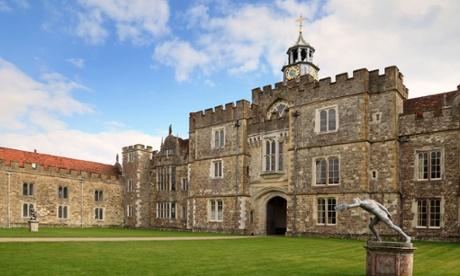Marks discovered during extensive conservation were carved within months of Gunpowder Plot at great house in Sevenoaks for anticipated visit of James I
Maev Kennedy
Source - http://www.theguardian.com/culture/2014/nov/05/witch-marks-king-james-i-knole-sevenoaks-national-trust

17th-century witch marks under floorboards at Knole in Sevenoaks, discovered during the National Trust’s extensive conservation project. Photograph: Gareth Fuller/PA
The witch marks newly discovered under 17th-century floorboards at Knole must have worked: there is no record of witches flying down any of the scores of chimneys of one of the largest houses in England. Unfortunately, the king they were designed to protect never came either.
The marks were carved at a time of national paranoia – within months of the failed Gunpowder Plot of November 1605 – for the anticipated visit of a king, James I, known to be fascinated by and terrified of witchcraft.
The craftsmen, working against the clock to construct sumptuous new state rooms in a medieval tower, took no chances: archaeologists found the marks not just in the bed chamber prepared for James, but carved into the joists and around the fireplace of the room directly overhead, which would probably have been occupied by one of his sons or a close member of his retinue.
The revelation of another element of Knole’s 600-year history would undoubtedly have fascinated Virginia Woolf, who set her novel Orlando in the family home of her lover Vita Sackville-West. Vita and her sisters could not inherit, and so had to watch the home they loved pass to an uncle.
The marks, made in the enormous oak beams on the sides facing the fireplace – for the superstitious, a known weak spot in defence against witches – include scorch marks made with a candle flame before the timbers were installed, carved tangles of Vs and Ws invoking the protection of the Virgin Mary, and maze-like marks known as demon traps, intended to trap the malevolent spirits which would follow the lines and be unable to find their way back out.

Courtyard at Knole. Photograph: Tony Watson / Alamy/Alamy
“These all relate very closely to Roman Catholicism, and by 1606 Knole was a Protestant house in a Protestant kingdom – but these old superstitions, dating back to medieval times and earlier, took a very long time to die out,” James Wright, a buildings archaeologist from the Museum of London Archaeology unit who has spent months crawling through attics and under floorboards, said. “The workmen may never have consulted the owner about this, they just knew what had to be done.”
In 1606 Knole was owned by Thomas Sackville, treasurer to James I, who might have been blown sky high along with his king and parliament if the Gunpowder Plot had succeeded. The king, who wrote a book on his beliefs, had also survived a mighty storm at sea which he believed had been raised by witches, and hundreds died in the subsequent witch trials in which he took a keen personal interest.
Official propaganda in the wake of the Gunpowder Plot repeatedly suggested demonic influence among the Catholic conspirators.
There has often been passionate argument among building historians about dating witch marks and whether they are really just carpenters’ marks to guide the placing of timbers. Wright pointed out that at Knole, most unusually, the carving and the building work can both be precisely dated, and the same beam has completely separate and different carpenters’ marks. Dating by tree rings proves the oak was felled in 1606, and the marks were cut before the beams were installed as green unseasoned timber.

Charlotte Bossick of Museum of London Archaeology looks at the 17th-century witch marks found under floorboards at Knole. Photograph: Gareth Fuller/PA
Sackville’s work preparing his house for a royal visit was complete by 1608, but he died soon afterwards and his son and grandson never enjoyed the same influence at court, so the king never tested Knole’s supernatural defences.
The house in its 1,000-acre deer park at Sevenoaks, Kent, is still partly occupied by the Sackville family, but has been a National Trust property since 1946. The trust is now well into the second £18m phase of the most extensive conservation project in the history of the building, which has allowed the archaeologists to crawl into spaces covered up for centuries.
Some of the newly discovered spaces, including a half metre wide secret chamber in the chapel which Wright edged into very nervously, were probably created by the endless extension of Knole over centuries, until it had a room for every day of the year. Some rooms, including a magnificently battered 17th-century gallery with a floor undulating like a skate park ramp from the centuries it spent carrying the enormous weight of the clock tower, will be open to the public for the first time when the work is complete.
Among the dusty treasures recovered by the archaeologists are scraps of 17th-century fabric and rush matting, 18th-century coins and bits of pottery, and some 20th-century car park tickets. Wright was particularly intrigued by a fine quality gilt embellished 19th-century vegetable tureen – smashed and, he suspects, shoved well in under the floorboards by some guilty servant to conceal a domestic disaster.